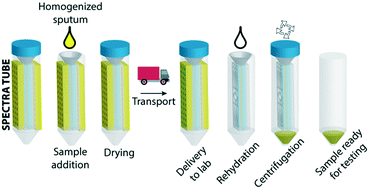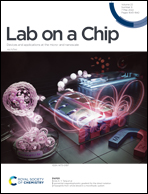A large-volume sputum dry storage and transportation device for molecular and culture-based diagnosis of tuberculosis†
Abstract
Technologies for preservation of specimens in the absence of cold chains are essential for optimum utilization of existing laboratory services in the developing world. We present a prototype called specimen transportation tube (SPECTRA-tube) for the collection, exposure-free drying, ambient transportation, and liquid state recovery of large-volume (>1 mL) specimens. Specimens introduced into the SPECTRA-tube are dried in glass fiber membranes, which are critical for efficient liquid-state sample recovery by rehydration and centrifugation. SPECTRA-tube is demonstrated for the dry storage of sputum for tuberculosis detection. Mycobacterium smegmatis (Msm)-spiked mock sputum dried in a native Standard 17 glass fiber was stable for molecular testing after 10 day storage at 45 °C and for culture testing after 10- and 5-day storage at 37 °C and 45 °C, respectively. Compatibility with human sputum storage was demonstrated by dry storing 1.2 mL Mycobacterium bovis-spiked human sputum in a SPECTRA-tube for 5 days at room temperature. We have thus demonstrated the first workflow for dry storage of sputum followed by molecular and culture testing. Compared to existing specimen dry storage technologies, SPECTRA-tube significantly increases the volume of liquid specimens that can be transported in the dry state and enables the recovery of the entire sample in the liquid state, rendering it compatible with conventional downstream analysis methods.

- This article is part of the themed collection: Miniaturised Sensors & Diagnostics


 Please wait while we load your content...
Please wait while we load your content...